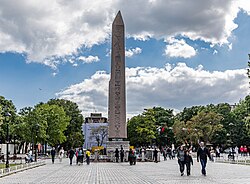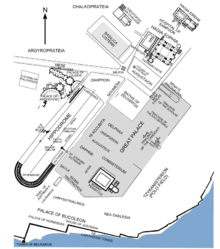Hippodrome of Constantinople
Parts of this article (those related to the modern square) need to be updated. (March 2021) |
This article needs additional citations for verification. (August 2023) |
| Hippodrome | |
|---|---|
| Sultanahmet Square (Sultanahmet Meydanı) | |
 Obelisk of Theodosius in Sultanahmet Square today | |
 | |
| Location | Istanbul, Turkey |
| Coordinates | 41°00′23″N 28°58′33″E / 41.00639°N 28.97583°E |
The Hippodrome of Constantinople (
The word
History and use
Construction

Although the Hippodrome is usually associated with Constantinople's days of glory as an imperial capital, it actually predates that era. The first Hippodrome was built when the city was called
In AD 324, the Emperor
The stands were capable of holding 100,000 spectators. The race-track at the Hippodrome was U-shaped, and the Kathisma (emperor's lodge) was located at the eastern end of the track. The Kathisma could be accessed directly from the Great Palace through a passage which only the emperor or other members of the imperial family could use.
Decoration
The hippodrome was filled with statues of gods, emperors, animals, and heroes, among them some famous works, such as a 4th-century BC
Functions
Throughout the Byzantine period, the Hippodrome was the centre of the city's social life. Huge amounts were bet on chariot races, and initially four teams took part in these races, each one financially sponsored and supported by a different political party (Deme) within the
A total of up to eight chariots (two chariots per team), powered by four horses each, competed on the racing track of the Hippodrome. These races were not simple sporting events, but also provided some of the rare occasions in which the emperor and the common citizens could come together in a single venue. Political discussions were often made at the Hippodrome, which could be directly accessed by the emperor through a passage that connected the Kathisma with the Great Palace of Constantinople.
The rivalry between the Blues and Greens often became mingled with political or religious rivalries, and sometimes riots, which amounted to civil wars that broke out in the city between them. The most severe of these was the Nika riots of 532, in which an estimated 30,000 people were killed[7] and many important buildings were destroyed, such as the nearby second Hagia Sophia, the Byzantine cathedral. The current (third) Hagia Sophia was built by Justinian I following the Nika riots.
Decline
Constantinople never recovered from its sack during the Fourth Crusade and even though the Byzantine Empire survived until 1453, by that time, the Hippodrome had fallen into ruin, pillaged by the Venetians who likely took the four horses now in San Marco from a monument there.[8] The Ottomans, whose Sultan Mehmed II captured the city in 1453 and made it the capital of the Ottoman Empire, were not interested in chariot racing and the Hippodrome was gradually forgotten, although the site was never actually built over. The hippodrome was used as a source of building stone, however.[9]
Hippodrome monuments
Serpent Column

To raise the image of his new capital, Constantine and his successors, especially
Obelisk of Thutmose III
Another emperor to adorn the Hippodrome was
Walled Obelisk

In the 10th century the Emperor
Statues of Porphyrius
Seven statues were erected on the Spina of the Hippodrome in honour of Porphyrius the Charioteer, a legendary charioteer of the early 6th century who in his time raced for the two parties which were called "Greens" and "Blues". None of these statues have survived. The bases of two of them have survived and are displayed in the Istanbul Archaeological Museum.
Contemporary description

The area is officially called Sultanahmet Square. It is maintained by the Turkish government. The course of the old racetrack has been indicated with paving, although the actual track is some 2 m (6.6 ft) below the present surface. The surviving monuments of the Spina, the two obelisks and the Serpentine Column, now sit excavated in pits in a landscaped garden.
The German Fountain ("The Kaiser Wilhelm Fountain"), an octagonal domed fountain in neo-Byzantine style, which was constructed by the German government in 1900 to mark the visit of the German Emperor Wilhelm II to Istanbul in 1898, is located at the northern entrance to the Hippodrome area, right in front of the Blue Mosque.
In 1855,
The Hippodrome was depicted on the reverse of the Turkish 500 lira banknotes of 1953–1976.[13]
Image gallery
-
Sultanahmet Square from the sky, the surviving lower walls of the Sphendone of the Hippodrome is visible.
-
The four bronze horses that stood atop the Hippodrome boxes, today at St. Mark's Basilica in Venice
-
Base of the statues of Porphyrios, kept in the Istanbul Museum
-
Capital withpegasi, probably 6th-century, possibly from the kathisma
-
The Hippodrome in 2005, with the Walled Obelisk in the foreground and the Obelisk of Thutmose III on the right
-
The base of the Obelisk of Thutmose III showing Emperor Theodosius as he offers a laurel wreath to the victor from the Kathisma at the Hippodrome
-
Procession of the guilds in front of the Sultan in the Hippodrome,Surname-i Vehbi(1582)
-
The Grand Vizier Crossing the Atmeydanı by Jean Baptiste Vanmour shows the Hippodrome and the Blue Mosque in the early 17th century
-
Watercolour of the Hippodrome's spina and Hagia Sophia from a manuscript in the library of Trinity College, Cambridge
-
Engraving by William Watts after Luigi Mayer of the Atmeydanı and the Blue Mosque
-
Depiction of an Arab captive demonstrating his skills to the emperor in the Hippodrome. Miniature from the 12th century Madrid Skylitzes.
References
- ^ a b "Hippodrome - Istanbul, Turkey Attractions". www.lonelyplanet.com.
- ^ E. Jeffreys et al. (eds.), The Oxford handbook of Byzantine studies (2008), 207; R. Krautheimer, Three Christian capitals: topography and politics (1983), 136 n. 14.
- ^ Dash, Mike. "Blue versus Green: Rocking the Byzantine Empire".
- JSTOR 1291694.
- S2CID 162820978.
- ^ Patria of Constantinople
- ^ This is the number given by Procopius, Wars (Internet Medieval Sourcebook.)
- ^ "Museo San Marco Venezia - St Mark's Museum Venice Italy". www.venetoinside.com.
- ^ "Hippodrome - architecture". Encyclopedia Britannica.
- ^ Thomas F. Madden, "The Serpent Column of Delphi in Constantinople: Placement, Purposes, and Mutilations," Byzantine and Modern Greek Studies 16 (1992): 111-45.
- ^ Erdem, Yasemin Tümer. "Atatürk Dönemi Arkeoloji Çalışmalarından Biri: Sultanahmet Kazısı," ATATÜRK ARAŞTIRMA MERKEZİ DERGİSİ, Sayı 62, Cilt: XXI, July 2005. İstanbul’da yapılan başlıca arkeolojik araştırmalar = Principal Archeological Researches... İstanbul / Rüstem Duyuran. 1957.
- ^ "Retrieved on 11 March 2010". Archived from the original on 22 December 2016. Retrieved 14 January 2020.
- ^ Central Bank of the Republic of Turkey Archived 2009-06-03 at WebCite. Banknote Museum: 5. Emission Group - Five Hundred Turkish Lira - I. Series Archived 2009-02-04 at the Wayback Machine, II. Series Archived 2009-02-04 at the Wayback Machine, III. Series Archived 2009-02-04 at the Wayback Machine & IV. Series Archived 2009-02-04 at the Wayback Machine. – Retrieved on 20 April 2009.
- ^ "An illustration of Byzantine era Constantinople, with the Hippodrome of Constantinople appearing prominently at the center of the image". vividmaps.com. Retrieved 31 January 2021.
- ^ "Aerial view of the Hippodrome of Constantinople, with the surviving lower walls of the Sphendone (curved grandstand) in the foreground". Retrieved 31 January 2021.
Further reading
- ISBN 9780870991790; full text available online from The Metropolitan Museum of Art Libraries
- Pitarakis, Brigitte & Isin, Ekrem, ed., Hippodrom/Atmeydani: istanbul’un tarih sahnesi - Hippodrome/Atmeydani: A stage for Istanbul’s history, 2 volumes, 2010, Pera Müsezi, Istanbul.
- Langdale, Allan. The Hippodrome of Istanbul / Constantinople: an illustrated handbook of its history (2019).
External links
- Byzantium 1200 | Hippodrome with images of original appearance
- Over 150 pictures of the monuments
- Photos with explanations


![The surviving lower walls of the Sphendone, the curved grandstand[14][15] of the Hippodrome](http://upload.wikimedia.org/wikipedia/commons/thumb/d/dc/Hippodrome_Sphendone_Constantinopel_March_2008panoc.jpg/120px-Hippodrome_Sphendone_Constantinopel_March_2008panoc.jpg)









